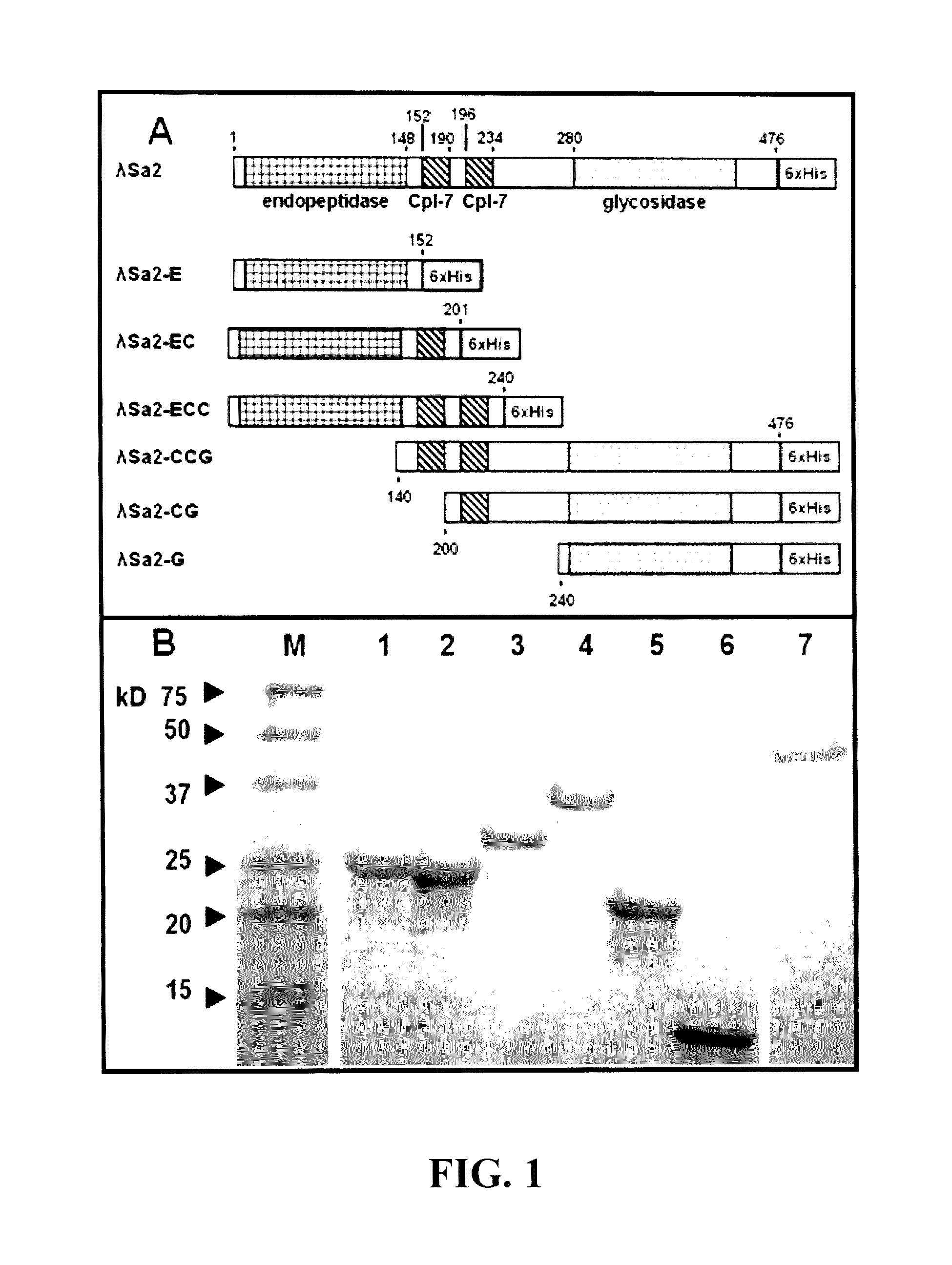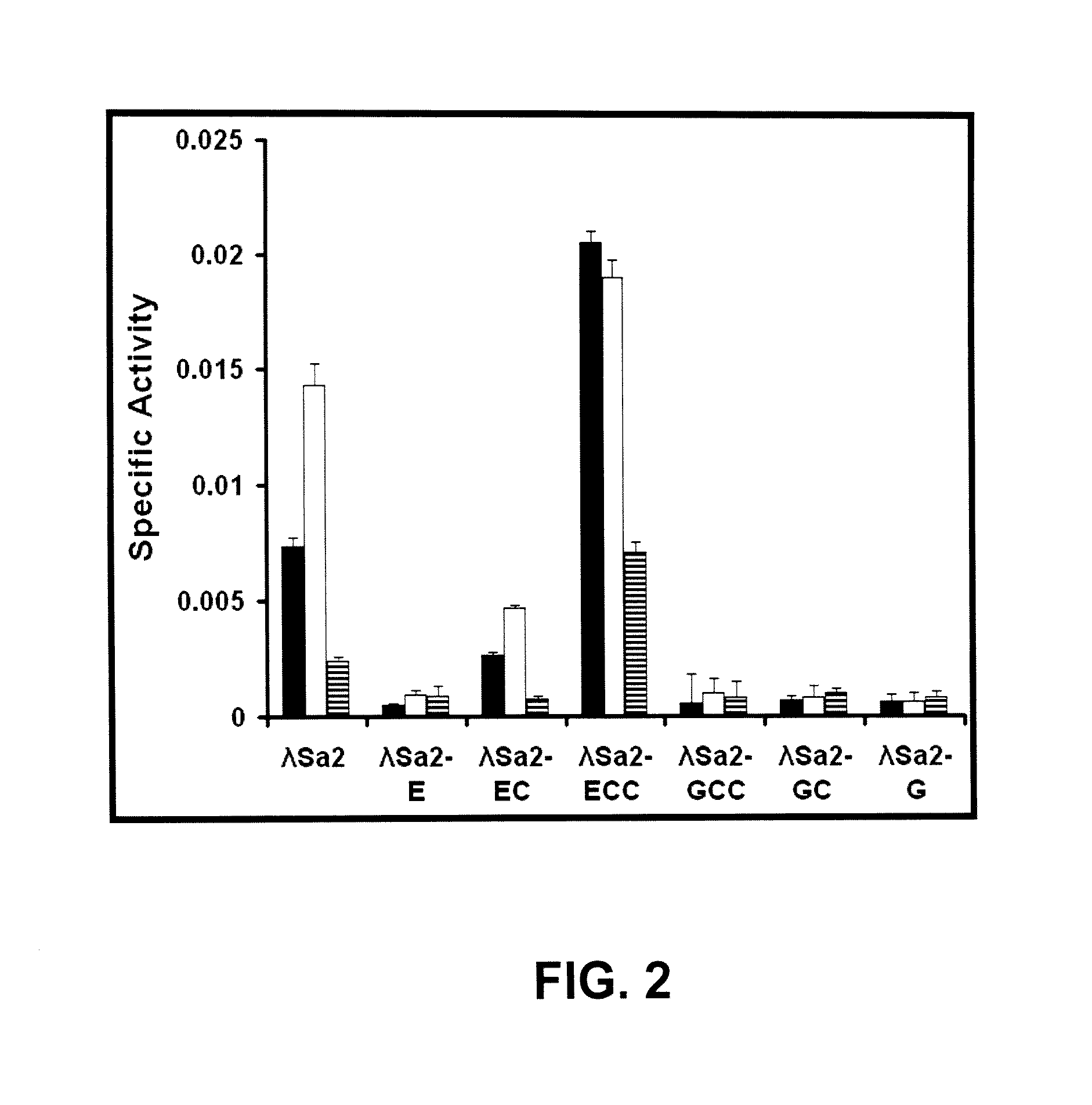Isolated recombinant cDNA
a recombinant cdna and recombinant technology, applied in the field of nucleic acid, can solve the problems of difficult to imagine how these structures themselves confer specificity to lysins, no resistance strain development, and complicated apparent inconsistency, so as to enhance the exolysis of streptococcus, enhance the exolysis of staphylococcus, and enhance the activity of endopeptidas
- Summary
- Abstract
- Description
- Claims
- Application Information
AI Technical Summary
Benefits of technology
Problems solved by technology
Method used
Image
Examples
example 1
Plasmids, Constructs and Strains
[0081]The strains used include: the bovine mastitis isolates S. agalactiae, S. dysgalactiae, S. uberis, S. chronogenes, S. epidermis, S. simulans, S. warneri, and S. xylocus (a gift from M. Paape, USDA, Beltsville, Md.). S. dysgalactiae subs. equisimilis 26RP66 (Rockefeller Univ. strain), S. equi subs. equi (ATCC 9528), S. equi subs. zooepidemicus (ATCC 700400), and S. aureus RN4220 (originally from Richard Novak), were each a gift from Daniel Nelson, Univ. MD. Other staphylococcal strains include Staphylococcus aureus Newbolt 305 capsular polysaccharide serotype 5 (ATCC 29740), and the MRSA USA300, from NARSA. S. pyogenes (MGAS 802A374), GES and GGS were gifts from David Pritchard, Univ. Alabama Birmingham.
[0082]The LambdaSa2 gene in pET21a (EMD Biosciences, San Diego, Calif.) was obtained as a gift from David Pritchard (Pritchard et al. 2007, supra). Inducible plasmid constructs were created in pET21a for introduction of a C-terminal His-tag. Gene f...
example 2
Protein Purification and Analysis
[0086]Mid log phase (OD600nm of 0.4-0.6) E. coli cultures harboring pET21a-derived expression vectors were grown under ampicillin selection, chilled on ice for 30 min, induced with 1 mM IPTG, and incubated with shaking for 18 h at 19° C. E. coli harvested from 100 ml cultures were suspended in 2 ml lysis buffer (50 mM NaH2PO4, 300 mM NaCl, 10 mM imidazole, pH 8), sonicated on ice for 15×5 sec pulses separated by 15 sec rests, and centrifuged at 6800 rpm for 30 min. in a Sorvall HS4 rotor. The cleared supernatant was applied to 1 ml Ni-NTA Agarose (nickel matrix) in a slurry and mixed gently for 1 hour at 4° C. (Qiagen). The wash and elution buffer profiles were empirically determined for all constructs to be 10 ml of 10 mM imidazole, 20 ml of 20 mM imidazole and eluted into 1.2 ml of 250 mM imidazole in the same phosphate buffered saline (50 mM NaH2PO4, 300 mM NaCl, pH 8.0). 1% glycerol was added immediately to the eluate to avoid potential solubilit...
example 3
[0088]The turbidity assay measures the drop in optical density (OD) resulting from lysis of the target bacteria with the phage endolysin-derived protein. A standardized turbidity assay modified from (Donovan et al. 2006a. Appl. Environ. Microbiol. 72:2988-2996) with S. aureus grown to logarithmic phase (A600nm=0.4-0.6) at 37° C. in Brain Heart Infusion broth (DIFCO, Franklin Lakes, N.J.) were performed in a 96 well dish and analyzed in a plate reader. Log phase cultures were harvested at 4° C. by centrifugation and stored on ice less than 4 hours until just before the assay when they were suspended in 150 mM NaCl, 10 mM Tris-CI, pH 7.5 or 50 mM Phosphate buffer, pH 7.5 to an A600nm ˜1.0. Enzyme samples are added to three wells of a 96 well dish in 100 μl of buffer (Ni-NTA elution buffer or storage buffer were shown to be equivalent). All samples are performed in triplicate. The assay is started by the addition of 100 μl of cells in buffer at A600m ˜1.0 via m...
PUM
| Property | Measurement | Unit |
|---|---|---|
| Mass | aaaaa | aaaaa |
| Mass | aaaaa | aaaaa |
| Antimicrobial properties | aaaaa | aaaaa |
Abstract
Description
Claims
Application Information
 Login to View More
Login to View More - R&D
- Intellectual Property
- Life Sciences
- Materials
- Tech Scout
- Unparalleled Data Quality
- Higher Quality Content
- 60% Fewer Hallucinations
Browse by: Latest US Patents, China's latest patents, Technical Efficacy Thesaurus, Application Domain, Technology Topic, Popular Technical Reports.
© 2025 PatSnap. All rights reserved.Legal|Privacy policy|Modern Slavery Act Transparency Statement|Sitemap|About US| Contact US: help@patsnap.com



